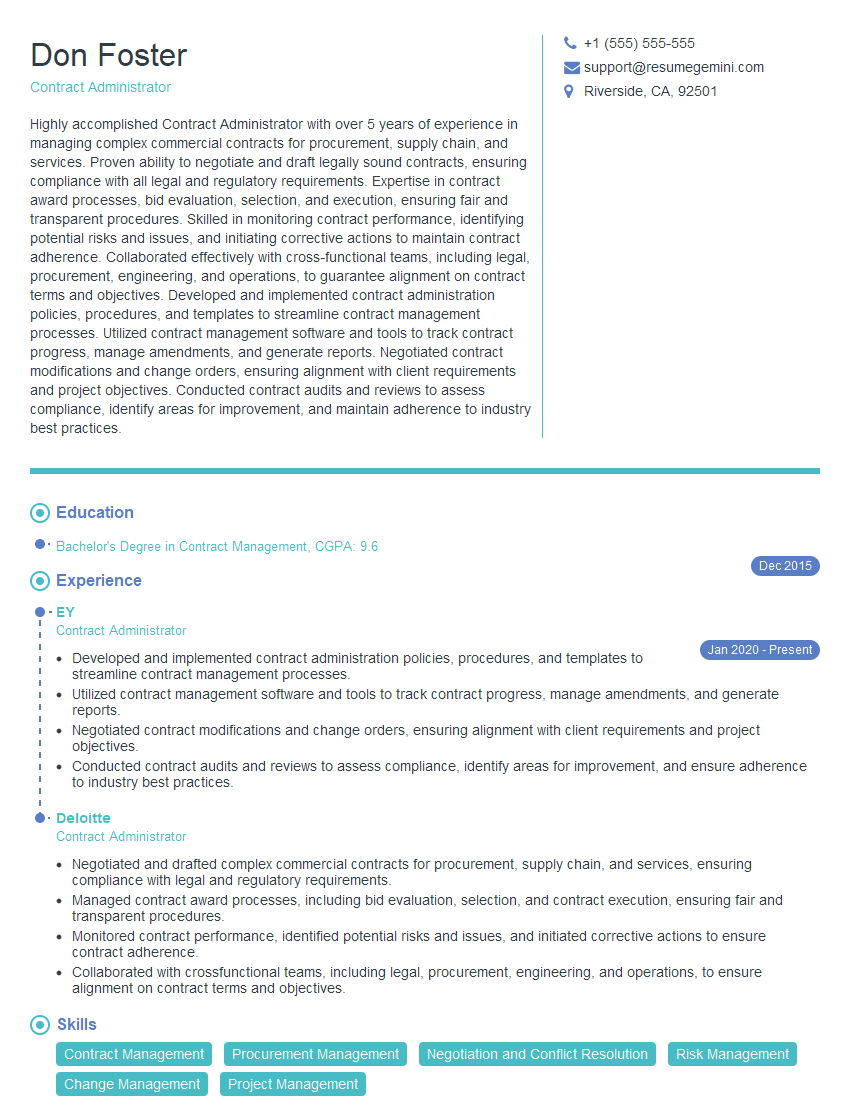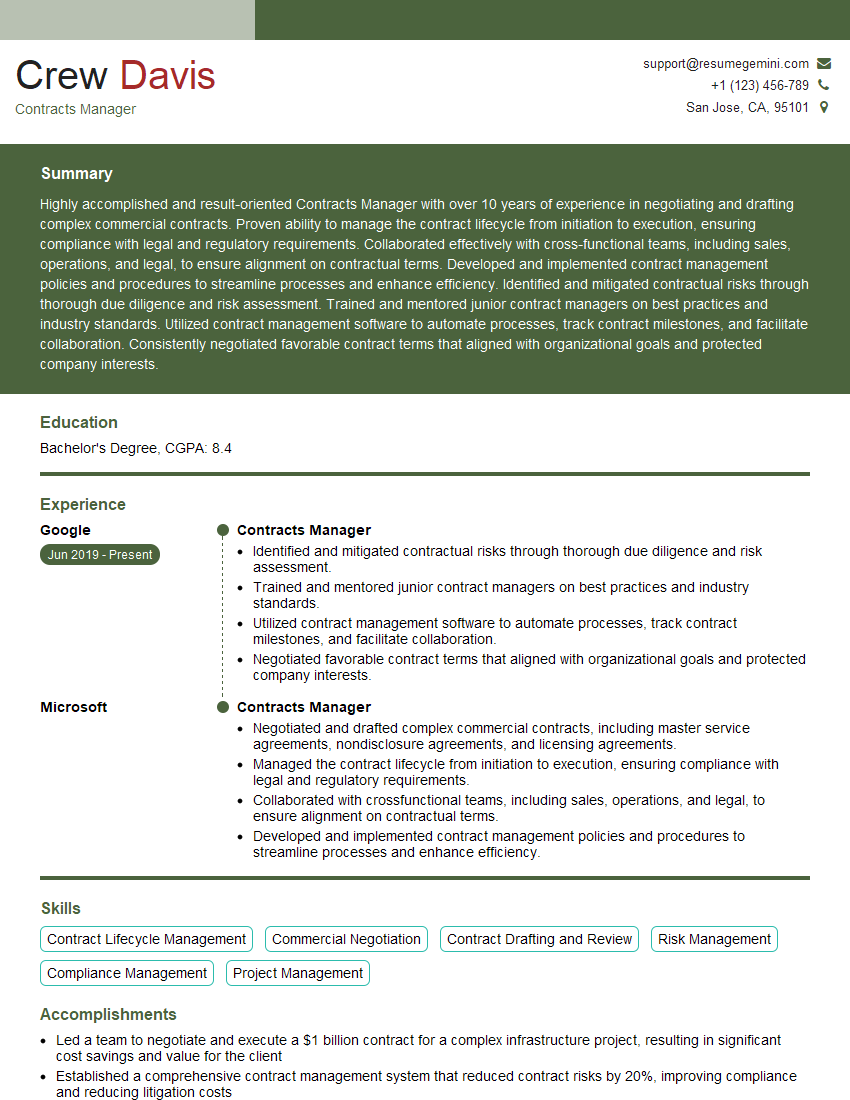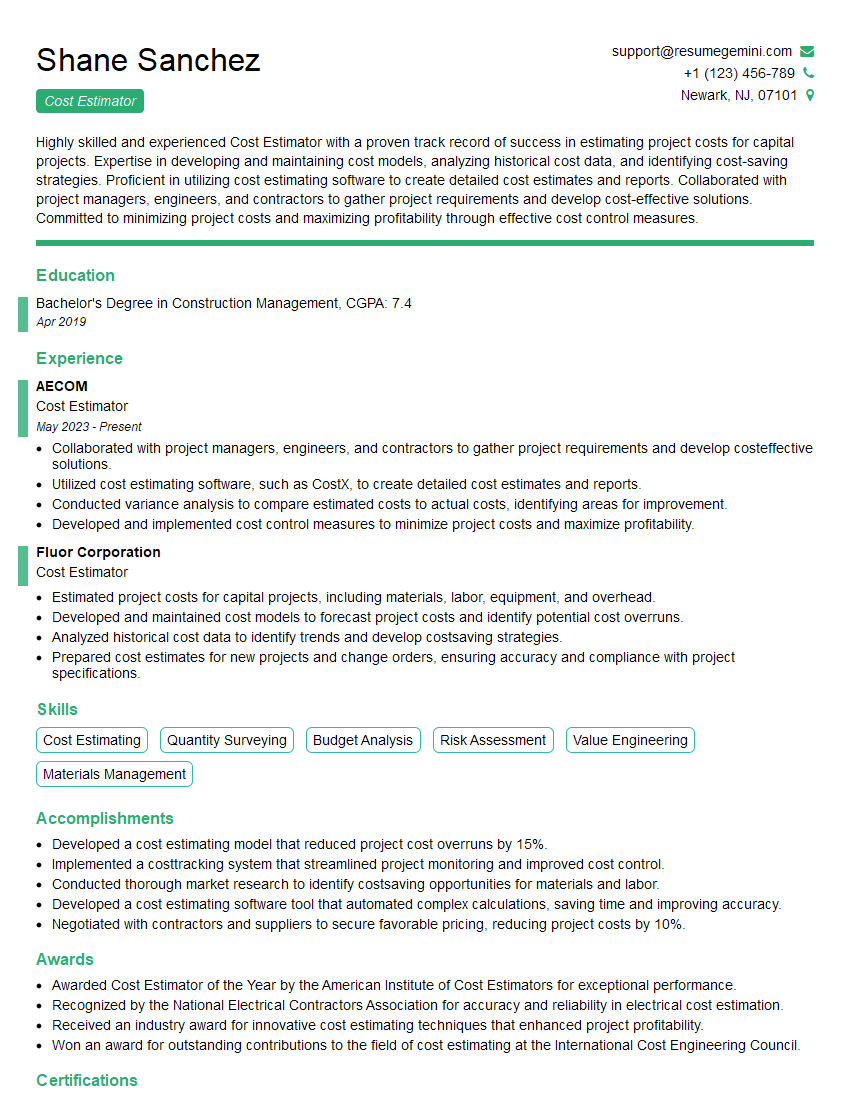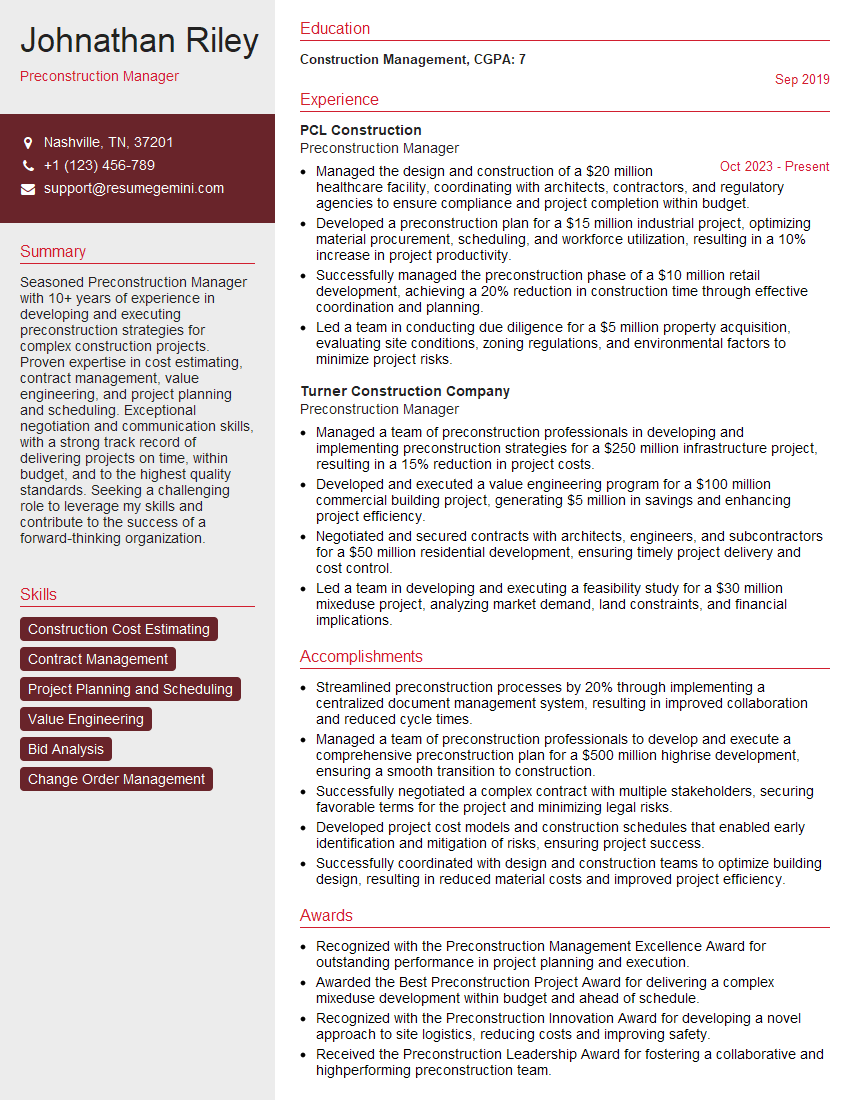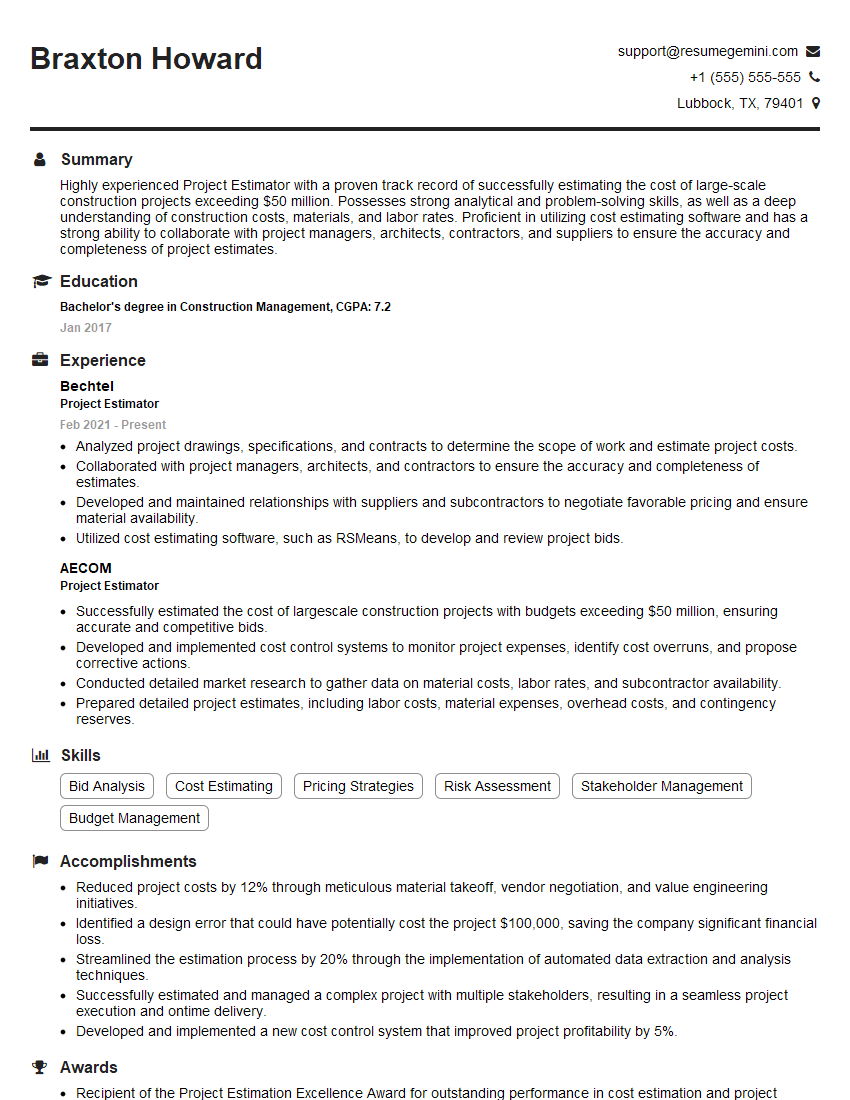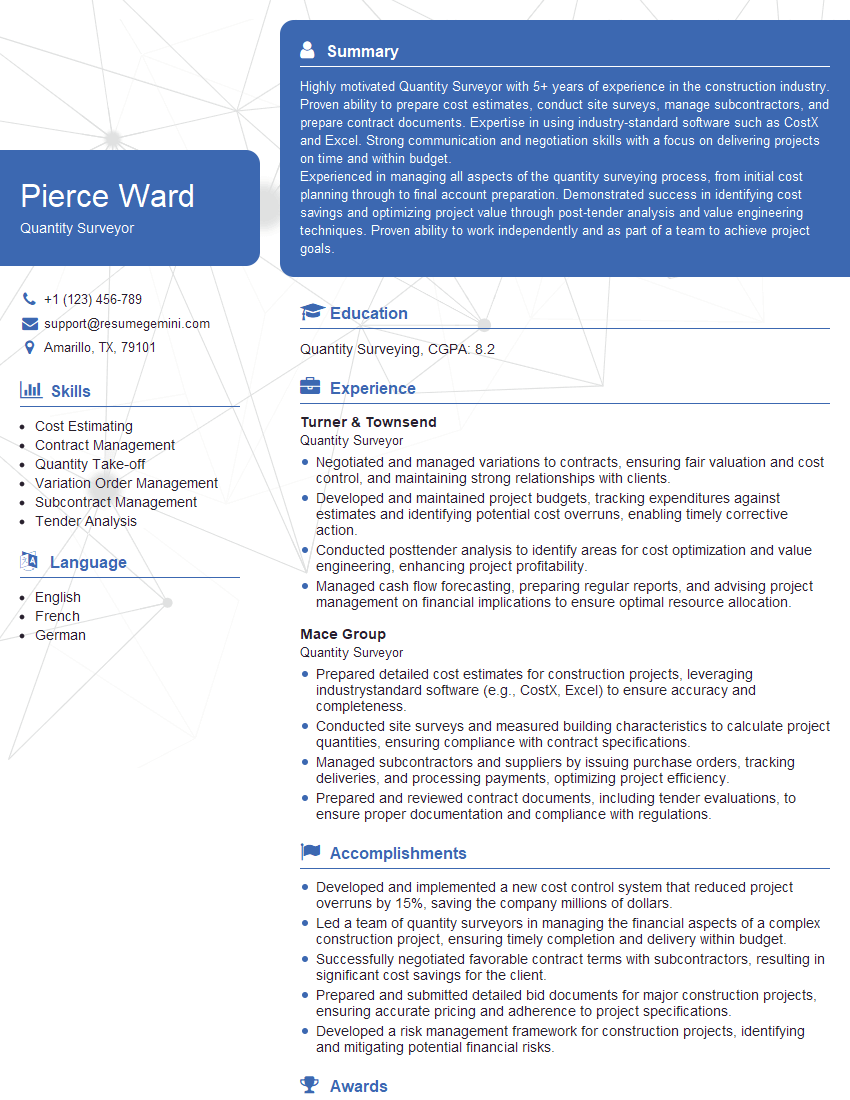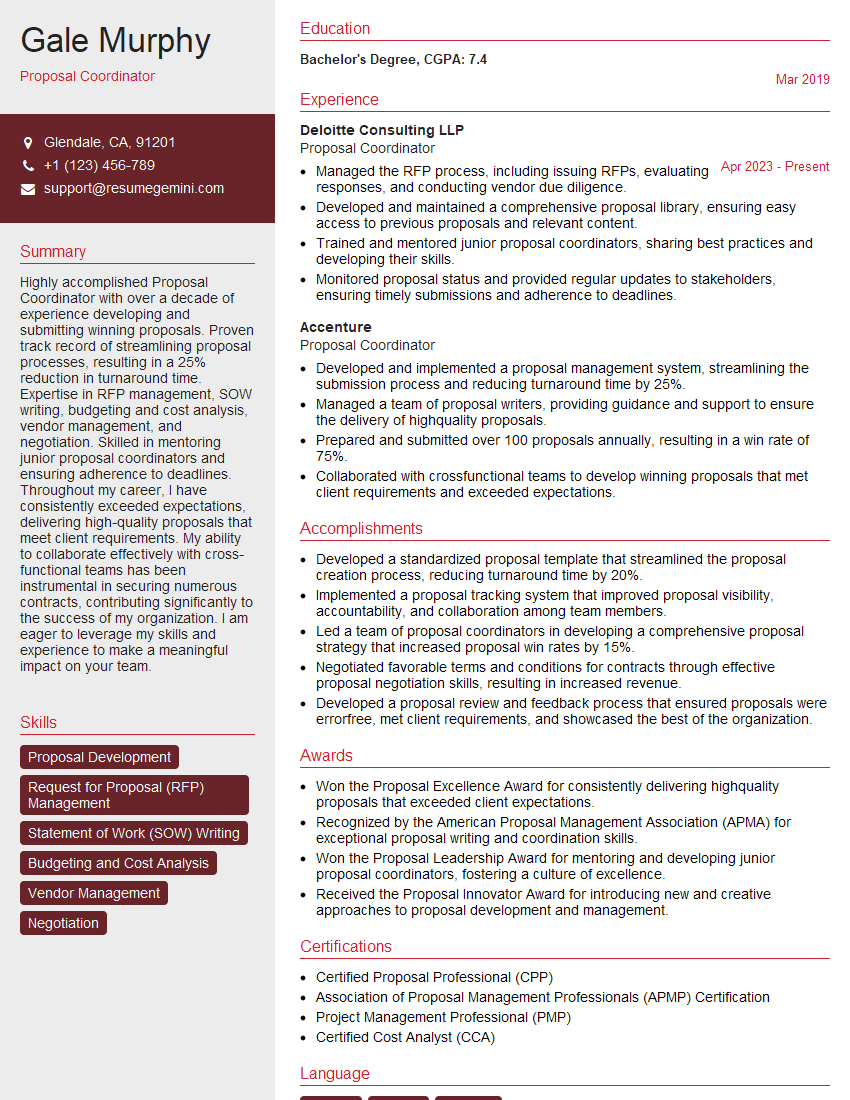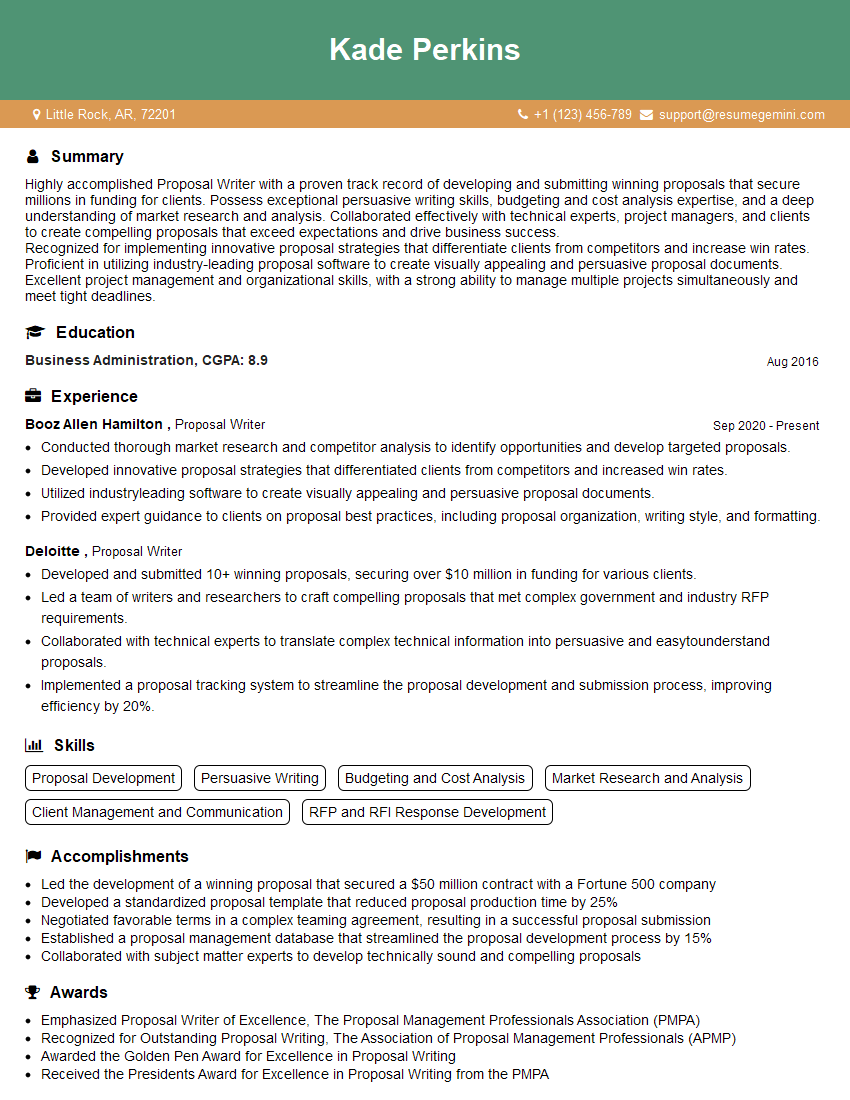Interviews are opportunities to demonstrate your expertise, and this guide is here to help you shine. Explore the essential Contractor Bidding and Proposal Preparation interview questions that employers frequently ask, paired with strategies for crafting responses that set you apart from the competition.
Questions Asked in Contractor Bidding and Proposal Preparation Interview
Q 1. Explain your experience in developing comprehensive cost estimates.
Developing accurate cost estimates is the cornerstone of successful bidding. My approach involves a meticulous breakdown of the project into its individual components, considering all direct and indirect costs. This starts with a thorough review of the project plans and specifications to identify all required materials, labor, equipment, and subcontracts.
For example, in a recent school renovation project, I broke down the costs into separate line items for demolition, electrical work, plumbing, HVAC, carpentry, painting, and landscaping. Each line item then received a detailed cost estimate, factoring in material costs, labor hours at prevailing wage rates, equipment rental fees, and potential waste disposal expenses. I also incorporated contingency buffers for unforeseen circumstances, typically ranging from 5-10% depending on the project’s complexity and potential risks.
I leverage historical data from previous projects to inform my estimates, adjusting for inflation and market fluctuations. Software like CostOS and Timberline helps automate calculations and track costs efficiently. Finally, I always perform a thorough review and sensitivity analysis to identify areas where cost overruns are most likely and to ensure the overall estimate is realistic and competitive.
Q 2. Describe your process for analyzing project plans and specifications.
Analyzing project plans and specifications requires a systematic and detailed approach. I begin by carefully reviewing all drawings, specifications, and addenda to fully understand the scope of work. This includes identifying the type and quantity of materials, required labor, and any special requirements or constraints.
I use a checklist to ensure I haven’t missed any critical details. This might include checking for potential conflicts between different sections of the plans or ambiguities in the specifications that could lead to disputes or cost overruns later. For instance, I might notice a discrepancy between the architectural drawings and the structural engineering drawings, which could have significant cost implications.
I then create a detailed breakdown of the project tasks, sequencing them logically to determine the critical path. This helps to identify potential bottlenecks and allows for better resource allocation and scheduling. This level of detail is crucial for accurate cost estimation and risk mitigation.
Q 3. How do you identify and mitigate potential risks in a construction bid?
Risk identification and mitigation are critical in competitive bidding. I utilize a structured approach involving brainstorming, checklist reviews, and historical data analysis to identify potential risks. This could include material price fluctuations, labor shortages, unforeseen site conditions (e.g., underground utilities), weather delays, and regulatory changes.
For each identified risk, I develop mitigation strategies. For example, if material prices are volatile, I may explore using alternative materials or securing materials through early contracts. To mitigate the risk of labor shortages, I build contingency into the schedule and potentially engage multiple subcontractors. For unforeseen site conditions, I include a contingency buffer in my cost estimate and specify thorough site investigation as part of the pre-construction phase.
I document all identified risks and mitigation strategies within the proposal, providing transparency to the client and demonstrating a proactive approach to project management. This process is iterative, constantly refined as more information becomes available throughout the bidding process.
Q 4. What software programs are you proficient in for cost estimation and proposal preparation?
Proficiency in various software programs is essential for efficient cost estimation and proposal preparation. I’m highly proficient in several industry-standard software packages including:
- CostOS: For detailed cost estimation, tracking, and reporting.
- Timberline (Primavera P6): For scheduling and resource allocation.
- Microsoft Office Suite (Excel, Word, PowerPoint): For data analysis, report generation, and proposal writing.
- Bluebeam Revu: For reviewing and markup of construction plans.
My experience with these tools allows me to streamline the bidding process, accurately track costs, and create professional, comprehensive proposals.
Q 5. How do you manage and track multiple bids simultaneously?
Managing multiple bids simultaneously requires strong organizational skills and effective time management. I employ a project management approach, treating each bid as a separate project with defined timelines and milestones. I utilize project management software to track deadlines and ensure that each bid receives the necessary attention.
I create a centralized database to store all relevant documents and information for each bid. This includes project plans, specifications, cost estimates, and subcontractor quotes. This helps maintain consistency and prevent errors. I regularly review my progress against the deadlines, prioritizing tasks based on the bid’s importance and impending deadline.
Delegation is also key. If the workload necessitates, I will assemble a team and assign specific responsibilities to ensure each aspect of each bid is handled accurately and efficiently. Regular team meetings help keep everyone aligned and informed.
Q 6. Explain your understanding of different bidding methods (e.g., competitive bidding, negotiated bidding).
Understanding different bidding methods is vital for success in the construction industry. Two common methods are competitive bidding and negotiated bidding.
- Competitive Bidding: Involves submitting a sealed bid against other contractors, with the lowest compliant bid typically winning. This is usually employed for public works projects and requires rigorous cost control and thorough risk assessment to ensure competitiveness while still maintaining profitability.
- Negotiated Bidding: Involves direct negotiations between the owner and the contractor, allowing for more flexibility and potential for a collaborative approach. This is more commonly used for private projects or complex projects where a close working relationship with the owner is beneficial. This method often allows for adjustments during the project as unforeseen issues arise.
My experience encompasses both methods, and I adapt my approach accordingly to maximize the chances of winning the contract while ensuring the project’s feasibility and profitability.
Q 7. Describe your experience with subcontractor bidding and selection.
Subcontractor bidding and selection are critical to successful project delivery. My process starts with a detailed breakdown of the work into individual packages suitable for subcontracting. I then prequalify potential subcontractors based on their experience, reputation, financial stability, and insurance coverage. This helps to ensure that only qualified and reliable subcontractors are considered.
I distribute bid documents to selected subcontractors, specifying clear requirements and deadlines. I follow up to answer any questions and ensure all subcontractors have a clear understanding of the scope of work. Once bids are received, I thoroughly evaluate them considering price, experience, reputation, and proposed schedule.
I don’t solely focus on the lowest price. A balance of price and reliability is essential. A higher bid from a reliable subcontractor with a proven track record may offer better value in the long run than a lower bid from a less reputable firm which could lead to delays and cost overruns. Once selected, I carefully manage the subcontractor relationships through regular communication and progress meetings.
Q 8. How do you ensure accuracy and completeness in cost estimations?
Ensuring accuracy and completeness in cost estimations is paramount for successful bidding. It’s a multi-step process that begins with a thorough understanding of the project scope. We start by meticulously reviewing the project plans, specifications, and drawings to identify all the necessary tasks and materials. Then, we break down the project into smaller, manageable work packages. This allows for more precise cost estimations for each component.
Next, we utilize various cost estimation techniques, including parametric estimating (using historical data and statistical models), detailed estimating (item-by-item breakdown), and bottom-up estimating (aggregating individual cost estimations). We also consider factors like labor costs (including wages, benefits, and overhead), material costs (accounting for potential price fluctuations and lead times), equipment costs (rental or ownership), and subcontractor costs. We regularly cross-check our estimations against industry benchmarks and utilize cost databases to ensure our figures are realistic and aligned with market rates. Finally, rigorous quality checks and peer reviews are performed to identify any discrepancies or oversights.
For example, in a recent project involving a large-scale renovation, we identified a potential oversight in the initial drawings related to specialized plumbing requirements. By carefully reviewing the specifications, we discovered the need for specialized fittings that increased the material costs by 15%. This early detection prevented significant cost overruns later in the project.
Q 9. How do you handle changes and revisions during the bidding process?
Handling changes and revisions during the bidding process is a crucial aspect of maintaining transparency and fairness. We establish a clear communication protocol with the client right from the start. This includes defining the process for submitting change requests, the timeframe for reviewing them, and the method for updating cost estimates. We use a change request log to meticulously track every change, including the date, description, impact on the cost and schedule, and the client’s approval.
If the changes are minor and within a predefined tolerance, we adjust our bid accordingly, keeping the client informed throughout the process. However, if the changes are significant, we will revisit the entire cost estimation process to ensure the new scope is reflected accurately. We may even need to submit a revised bid, clearly outlining the rationale behind the changes in cost. Transparency and open communication with the client are essential to avoid disputes down the line. For instance, in a recent project, an architectural change required an alteration in the foundation design. We promptly communicated the resulting increased cost (approximately 8% increase) and provided a detailed breakdown of the cost impact before proceeding.
Q 10. How do you present and defend your bids to clients?
Presenting and defending bids requires a strategic approach that emphasizes clarity, professionalism, and value. We begin by preparing a comprehensive proposal that’s not just a list of numbers, but a compelling narrative showcasing our understanding of the client’s needs and our ability to deliver an exceptional outcome. The proposal includes a detailed breakdown of our cost estimates, a description of our proposed approach and methodology, and a clear outline of the project timeline. It also showcases our company’s experience, qualifications, and relevant case studies to build confidence.
During the presentation, we focus on presenting the value proposition, highlighting our cost-effective solutions and innovative approaches. We are prepared to answer any questions or concerns the client may have and address potential risks proactively. We use visuals like charts and graphs to make complex information easily digestible. We also emphasize our commitment to quality, safety, and adherence to deadlines. The ability to clearly and concisely explain our methodology and justify our pricing is key to securing the project.
Q 11. Explain your understanding of various contract types (e.g., lump sum, cost-plus).
Different contract types have varying levels of risk and responsibility for the contractor and the client. Understanding these differences is critical for successful project execution.
- Lump Sum Contracts: The contractor agrees to complete the project for a fixed price, regardless of unforeseen challenges. The risk is largely on the contractor to accurately estimate costs and manage the project efficiently. It offers predictability for the client, but it requires meticulous planning and accurate budgeting from the contractor.
- Cost-Plus Contracts: The client reimburses the contractor for all allowable costs, plus a predetermined fee or percentage markup (profit). The risk is shifted more towards the client, who bears the responsibility for potential cost overruns. This contract type is often used for projects with uncertain scopes or complex designs, allowing for greater flexibility.
- Unit Price Contracts: The contractor is paid a predetermined price per unit of work (e.g., per square foot, per hour). This is suitable for projects with clearly defined quantities and unit rates. It offers a balance of risk between the client and contractor.
Choosing the appropriate contract type depends on the specific project, client preferences, and risk tolerance. We discuss these options thoroughly with the client to find the best fit.
Q 12. How do you incorporate contingency and profit margins into your cost estimates?
Incorporating contingency and profit margins into cost estimates is crucial for mitigating risk and ensuring profitability. Contingency accounts for unforeseen expenses or delays. It’s expressed as a percentage of the estimated cost, varying depending on the project’s complexity and potential risks. For example, a complex project with significant unknowns might require a 10-15% contingency, while a simpler project might need only 5-7%.
Profit margin represents the contractor’s desired profit and covers overhead costs (rent, administrative expenses, etc.). It’s also expressed as a percentage of the total estimated cost, usually ranging from 10-20%, depending on various factors like market conditions and competition. For example, a project with lower competition could support a higher profit margin. The contingency and profit margins are added to the direct costs (labor, materials, equipment) to arrive at the final bid price. The accurate calculation of these margins is critical for the financial viability and sustainability of our business.
Q 13. Describe your experience with value engineering.
Value engineering is a systematic approach to analyzing project designs and processes to identify cost reductions without compromising quality or functionality. It involves a collaborative effort between the contractor, the client, and other stakeholders to explore alternative materials, methods, and designs that achieve cost savings.
My experience with value engineering includes numerous instances where we’ve successfully reduced project costs by proposing alternative solutions without sacrificing the project’s overall objectives. For example, in a recent project involving the construction of a multi-story building, we suggested using prefabricated components instead of traditional on-site construction. This resulted in a 12% reduction in labor costs and a shorter construction time. We also identified opportunities to reduce material costs by substituting some materials with equally effective, but less expensive, alternatives.
Value engineering isn’t about cutting corners; it’s about finding creative and efficient solutions that deliver value for money. It requires a deep understanding of engineering principles, construction techniques, and market trends.
Q 14. How do you manage and resolve conflicts among team members during the bidding process?
Conflict resolution is a vital skill in team management, especially during the high-pressure environment of the bidding process. We foster a culture of open communication and respect from the outset. Team meetings are held regularly to discuss progress, address concerns, and proactively identify potential conflicts. We encourage everyone to voice their opinions and actively listen to differing viewpoints.
If conflicts do arise, we address them promptly and directly, using a structured approach. This may involve mediating discussions, clarifying roles and responsibilities, or providing additional training or resources if needed. The goal is not to suppress dissent, but to find common ground and reach mutually acceptable solutions. We focus on the issue, not the individuals involved, maintaining a professional and respectful tone throughout the process. Documentation of the conflict and the resolution is maintained for reference. For example, if a disagreement arises about the scheduling of specific tasks, we create a revised schedule collaboratively, based on a realistic evaluation of the workload and resource availability.
Q 15. How do you stay updated on industry trends and best practices in construction estimating?
Staying current in the dynamic construction estimating field requires a multi-pronged approach. It’s not just about knowing the latest software; it’s about understanding market shifts and emerging technologies. I actively participate in professional organizations like the Associated Builders and Contractors (ABC) and attend industry conferences and webinars to learn about new methodologies and software. I also subscribe to relevant trade publications and journals, such as Engineering News-Record (ENR), which provide insightful analysis and reports on industry trends. Further, I maintain a robust network of colleagues and mentors, engaging in regular discussions about best practices and challenges faced on various projects. This combination of formal and informal learning ensures I’m always equipped with the most up-to-date knowledge and techniques.
- Professional Organizations: Membership offers access to networking events, training, and publications.
- Industry Publications: ENR, Construction Dive, and similar publications offer market analysis and best-practice articles.
- Webinars and Conferences: These provide opportunities to learn about new technologies and methodologies directly from experts.
- Networking: Building relationships with peers facilitates knowledge sharing and problem-solving.
Career Expert Tips:
- Ace those interviews! Prepare effectively by reviewing the Top 50 Most Common Interview Questions on ResumeGemini.
- Navigate your job search with confidence! Explore a wide range of Career Tips on ResumeGemini. Learn about common challenges and recommendations to overcome them.
- Craft the perfect resume! Master the Art of Resume Writing with ResumeGemini’s guide. Showcase your unique qualifications and achievements effectively.
- Don’t miss out on holiday savings! Build your dream resume with ResumeGemini’s ATS optimized templates.
Q 16. Describe a challenging bid you worked on and how you overcame the obstacles.
One particularly challenging bid involved a historical renovation project in a densely populated urban area. The project required extensive demolition and reconstruction while minimizing disruption to surrounding businesses and residents. The primary obstacle was accurately estimating the cost of unforeseen conditions – we anticipated potential issues with subsurface utilities and historical materials, but the actual complexities exceeded our initial projections. To overcome this, we employed a phased approach to our estimate. We developed a base estimate based on our initial assessments, then added contingency reserves for potential unknowns, categorized by risk level. We also leveraged advanced 3D modeling and scanning technology to better visualize the existing conditions and refine our estimates. Further, we collaborated closely with specialized subcontractors experienced in historical preservation, getting multiple bids and rigorously analyzing each. Finally, we included a detailed risk assessment in our proposal, clearly outlining the potential for cost overruns and the strategies we would employ to mitigate them. This transparent approach ultimately won us the bid, demonstrating our understanding of the unique challenges and our capacity to manage them effectively.
Q 17. What is your experience with developing and managing a proposal budget?
Developing and managing a proposal budget is a crucial aspect of successful bidding. It’s not just about listing expenses; it’s about creating a comprehensive financial plan that accurately reflects the project scope, identifies potential risks, and ensures profitability. My experience includes creating detailed budget breakdowns, categorizing costs by labor, materials, equipment, and subcontractor fees. I utilize specialized estimating software to manage these budgets, enabling me to track costs in real-time and identify any variances from the original plan. I also incorporate contingency buffers to account for unforeseen expenses, aligning these buffers with the risk assessment. For example, on a recent project involving a complex structural element, I allocated a higher contingency for potential material defects or unforeseen repairs. Furthermore, regular review and updates are critical. I routinely monitor the budget during the proposal development process, making adjustments as needed based on new information or changes in the project scope. This ensures the proposal remains financially viable and competitive.
Q 18. Explain your experience with reviewing and analyzing subcontractor bids.
Reviewing and analyzing subcontractor bids is a critical part of the process; it directly impacts the overall bid’s competitiveness and profitability. My approach involves a systematic evaluation process. First, I verify that the bids are complete and meet all specified requirements – ensuring clear scope definition, payment terms, and insurance details. Then, I carefully compare the pricing from different subcontractors, considering factors like experience, reputation, and the overall quality of their proposal. I look beyond just the bottom line; I analyze unit rates to identify any anomalies or inconsistencies. If I find inconsistencies I’ll reach out to the subcontractor to clarify. For example, unusually low bids may signal potential quality compromises, while significantly high bids might require further investigation to identify the reasons. This process also includes verifying the subcontractor’s licensing and insurance coverage to mitigate risk. Finally, I document all my findings, making it easier to justify my selection to clients and to track cost trends for future projects. This meticulous process helps select the most qualified and cost-effective subcontractors, minimizing potential risks and maximizing the project’s success.
Q 19. How do you determine the appropriate level of detail for a proposal?
Determining the appropriate level of detail in a proposal depends heavily on the project’s complexity, the client’s requirements, and the bidding process. For smaller, simpler projects, a concise proposal highlighting key deliverables and pricing might suffice. However, for larger, more complex projects, a detailed proposal with comprehensive specifications, drawings, schedules, and risk assessments becomes essential. I tailor my approach to each project, carefully considering the client’s preferences and the level of information they require to make an informed decision. This involves a careful balance: providing sufficient detail to demonstrate competency and understanding without overwhelming the client with unnecessary information. For example, a proposal for a straightforward office renovation would need less detail than a proposal for a complex hospital expansion. Effective communication with the client throughout the proposal development process helps refine the level of detail and ensures alignment of expectations.
Q 20. Describe your experience with preparing compliant proposals that adhere to specific client requirements.
Preparing compliant proposals that strictly adhere to client requirements is paramount. This involves a thorough review of the request for proposal (RFP) or invitation to bid (ITB) documents. I carefully analyze each requirement, ensuring complete understanding and addressing every aspect in the proposal. This includes meticulously following formatting guidelines, using specified language, and incorporating all necessary documentation, such as certifications, insurance information, and project schedules. I also incorporate client-specific preferences and requirements, ensuring the proposal is customized to their specific needs. For example, if a client requires a specific project management methodology or reporting format, I ensure that my proposal clearly reflects this. Furthermore, I utilize checklists and templates to ensure compliance throughout the process. This systematic approach minimizes errors and maximizes the likelihood of proposal acceptance. A failure to meet client requirements can result in immediate disqualification.
Q 21. How do you ensure timely submission of proposals?
Timely submission of proposals is crucial for securing projects. My approach begins with a detailed project timeline, identifying key milestones and deadlines well in advance of the submission date. This includes allocating sufficient time for each stage of the proposal preparation process, from initial research and cost estimation to final review and submission. I utilize project management tools to track progress and identify any potential delays. For instance, I will establish clear communication protocols with the team, subcontractors, and client to maintain constant awareness of any issues. Should delays occur, I immediately implement contingency plans, such as adjusting the workload or securing additional resources. I also ensure that the proposal is submitted through the appropriate channels, adhering to any specific instructions provided by the client. Finally, confirmation of submission is always obtained to guarantee timely delivery and prevent unnecessary risks.
Q 22. How do you prioritize competing projects and deadlines?
Prioritizing competing projects and deadlines requires a strategic approach that balances profitability, resource availability, and client relationships. I utilize a weighted scoring system, considering factors like project value, urgency, resource allocation, and potential conflicts. For example, a high-value project with a tight deadline might receive a higher priority even if it requires juggling resources. I visually represent this using a project management tool like a Gantt chart, enabling me to see potential overlaps and adjust accordingly. This allows me to proactively identify and mitigate potential scheduling conflicts, ensuring timely delivery on all commitments.
- Step 1: Project Evaluation: Each project gets a score based on pre-defined criteria (e.g., profit margin, client importance, project complexity).
- Step 2: Resource Allocation: I assess the team’s capacity and allocate resources to projects based on their weighted scores. This might involve adjusting timelines or assigning additional personnel.
- Step 3: Regular Monitoring: I track progress regularly and adjust priorities as needed based on emerging challenges or opportunities. This flexibility is crucial for reacting to unexpected circumstances.
Q 23. How do you handle unexpected delays or changes in project scope during the bidding phase?
Unexpected delays or scope changes during the bidding phase are inevitable. My approach involves immediately communicating the change to the client, transparently explaining the impact on the timeline and budget. I then collaboratively work with the client to determine the best course of action – whether to adjust the proposal, extend the deadline, or even withdraw the bid if the changes are too significant. For instance, if a critical subcontractor becomes unavailable, I’ll explore alternative solutions and promptly inform the client, providing options and their implications. Open communication is key to maintaining trust and avoiding misunderstandings.
- Assess the Impact: Quantify the impact of the delay or scope change on the project timeline and budget.
- Communicate Proactively: Inform the client immediately, providing clear and concise details.
- Collaborate on Solutions: Work with the client to develop mutually acceptable solutions.
- Document Everything: Maintain thorough records of all communications and changes to the proposal.
Q 24. Describe your process for assembling and reviewing proposal documents.
My proposal assembly and review process is methodical and ensures a high-quality, consistent output. It starts with a detailed checklist to ensure all required documents are included (e.g., executive summary, project methodology, qualifications, pricing). I utilize a centralized document repository to manage all proposal components, avoiding version control issues. A team review process, including a final check by myself, is crucial for identifying inconsistencies and errors before submission. This ensures all stakeholders contribute, reducing errors and creating a more comprehensive proposal. For example, one team member might focus on the technical aspects while another handles the financial aspects.
- Checklist: A comprehensive checklist to track the inclusion of all necessary documents and sections.
- Document Repository: A centralized location to store and manage all proposal components.
- Team Review: Multiple levels of review by different team members specializing in various aspects of the proposal.
- Final Review: A final review by a senior member, such as myself, to catch any overlooked issues.
Q 25. How do you ensure the quality and consistency of your proposals?
Maintaining quality and consistency across proposals involves using templates, style guides, and standardized language. This ensures uniformity in presentation, tone, and formatting. We use a style guide that defines fonts, colors, and layouts, creating a professional and consistent brand image across all our proposals. Regular training for the team on the use of the templates and style guide helps maintain consistency. This creates a professional image for our company and simplifies the review process. For example, the same section headings, font sizes, and logos are used across all our proposals.
- Templates: Standardized templates for various proposal sections.
- Style Guides: Comprehensive style guides specifying formatting, fonts, and branding elements.
- Training: Regular training sessions to ensure consistent application of templates and style guides.
- Review Process: A multi-level review process to identify inconsistencies and maintain quality.
Q 26. What are your strengths and weaknesses in proposal preparation?
My strengths lie in my deep understanding of the bidding process, my ability to analyze complex projects, and my strong communication skills. I can quickly grasp project requirements and translate them into compelling proposals. However, a weakness could be my meticulous nature, which can sometimes lead to spending excessive time on details, potentially impacting deadlines if not managed well. I actively work on improving time management techniques to mitigate this, often using project management tools to break down tasks and track progress.
Q 27. How do you use data analytics to inform your bidding strategies?
Data analytics plays a crucial role in informing our bidding strategies. We analyze historical data on project costs, win rates, and client profiles to identify trends and patterns. For example, we might analyze past projects to understand the correlation between proposal pricing and win rates, helping us optimize our pricing strategies. We also use data to identify which types of projects we are most successful in bidding on, allowing us to focus our resources more effectively. This data-driven approach helps us make more informed decisions, increasing our chances of winning profitable projects.
- Cost Analysis: Analyzing historical project costs to estimate future project expenses accurately.
- Win Rate Analysis: Tracking win rates across different project types and clients to identify strengths and weaknesses.
- Client Profile Analysis: Understanding client preferences and needs to tailor proposals effectively.
- Market Research: Using data to understand market trends and competitor activity.
Q 28. Explain your understanding of the importance of clear and concise communication in the bidding process.
Clear and concise communication is paramount throughout the bidding process. It builds trust with clients, ensures a shared understanding of project requirements, and prevents costly misunderstandings later on. I prioritize using plain language, avoiding technical jargon unless absolutely necessary, and always ensuring that the client understands the proposal’s key elements. For example, when explaining a complex technical process, I use visuals and analogies to make it easier to understand. Open communication channels are maintained throughout the entire process, fostering a strong client relationship, and proactively addressing questions and concerns.
Key Topics to Learn for Contractor Bidding and Proposal Preparation Interview
- Understanding the RFP/RFQ Process: Learn to thoroughly analyze Request for Proposals (RFPs) and Request for Quotations (RFQs), identifying key requirements, deadlines, and evaluation criteria. Practical application involves demonstrating your ability to dissect a sample RFP and highlight crucial elements.
- Cost Estimating and Pricing Strategies: Master various cost estimation techniques, including bottom-up, top-down, and parametric methods. Understand different pricing strategies and their implications on profitability and competitiveness. Practice applying these methods to real-world scenarios and justifying your pricing decisions.
- Proposal Writing and Structure: Develop strong proposal writing skills, focusing on clear communication, persuasive language, and a compelling narrative. Understand the importance of a well-structured proposal that effectively addresses the client’s needs. Explore different proposal formats and learn to tailor them to specific client requirements.
- Risk Management and Mitigation: Identify potential risks associated with a project and develop strategies to mitigate them. This includes understanding contract law, insurance requirements, and potential project delays or cost overruns. Demonstrate your ability to proactively address potential problems.
- Team Collaboration and Communication: Highlight your experience in collaborating with diverse teams to prepare successful bids and proposals. Emphasize effective communication skills and your ability to manage internal stakeholders.
- Compliance and Regulatory Requirements: Demonstrate knowledge of relevant industry regulations, legal frameworks, and ethical considerations pertaining to bidding and proposal preparation. This includes understanding compliance requirements specific to your field.
Next Steps
Mastering Contractor Bidding and Proposal Preparation is crucial for career advancement in the construction, engineering, and technology sectors. It opens doors to higher-paying roles with increased responsibility and project leadership opportunities. To enhance your job prospects, create an ATS-friendly resume that showcases your skills and experience effectively. We highly recommend using ResumeGemini to build a professional and impactful resume. ResumeGemini provides resources and examples of resumes tailored to Contractor Bidding and Proposal Preparation, helping you present yourself as a strong candidate.
Explore more articles
Users Rating of Our Blogs
Share Your Experience
We value your feedback! Please rate our content and share your thoughts (optional).
What Readers Say About Our Blog
Hi, I have something for you and recorded a quick Loom video to show the kind of value I can bring to you.
Even if we don’t work together, I’m confident you’ll take away something valuable and learn a few new ideas.
Here’s the link: https://bit.ly/loom-video-daniel
Would love your thoughts after watching!
– Daniel
This was kind of a unique content I found around the specialized skills. Very helpful questions and good detailed answers.
Very Helpful blog, thank you Interviewgemini team.

